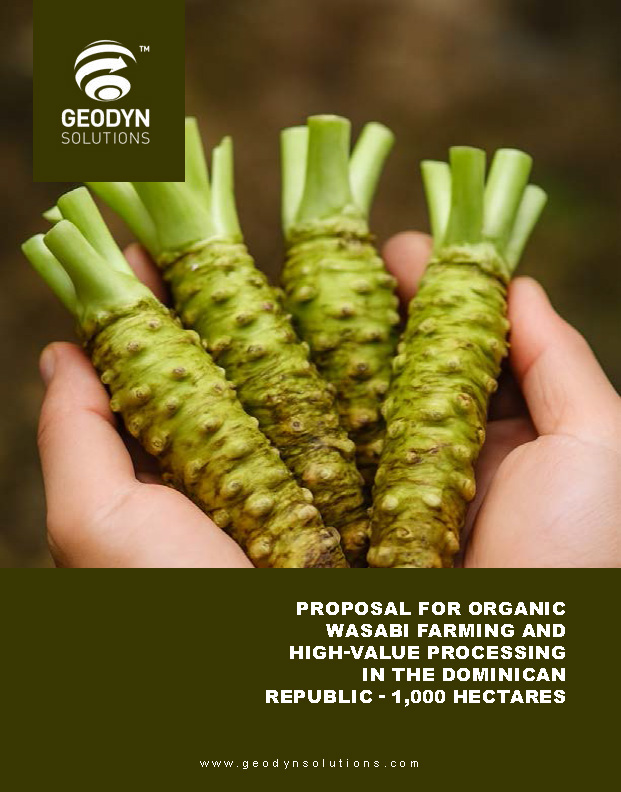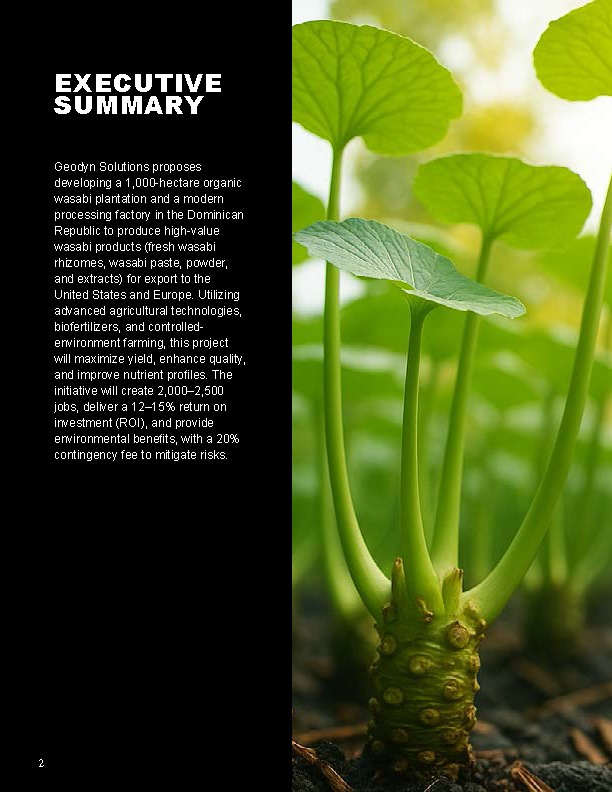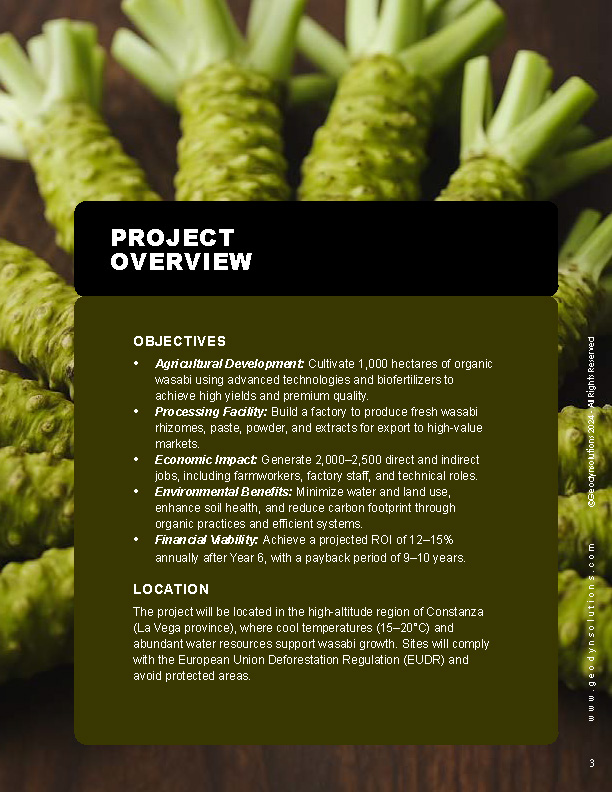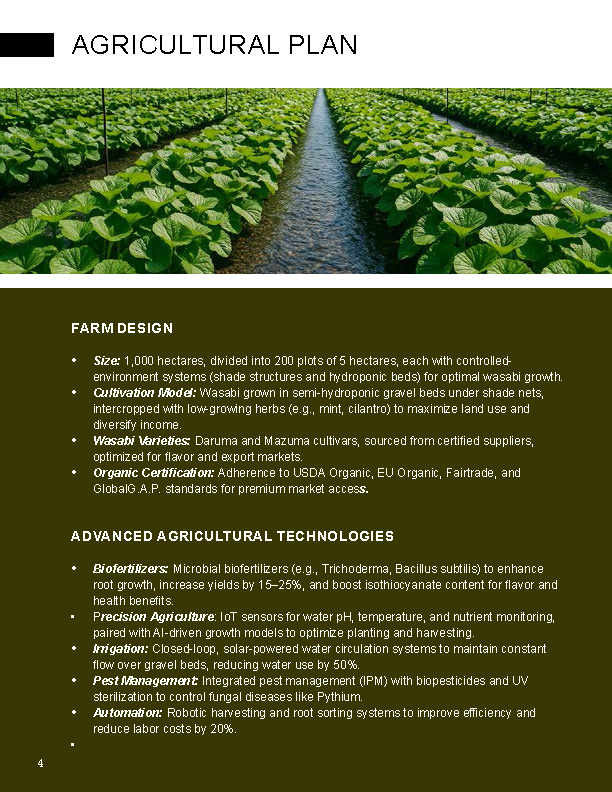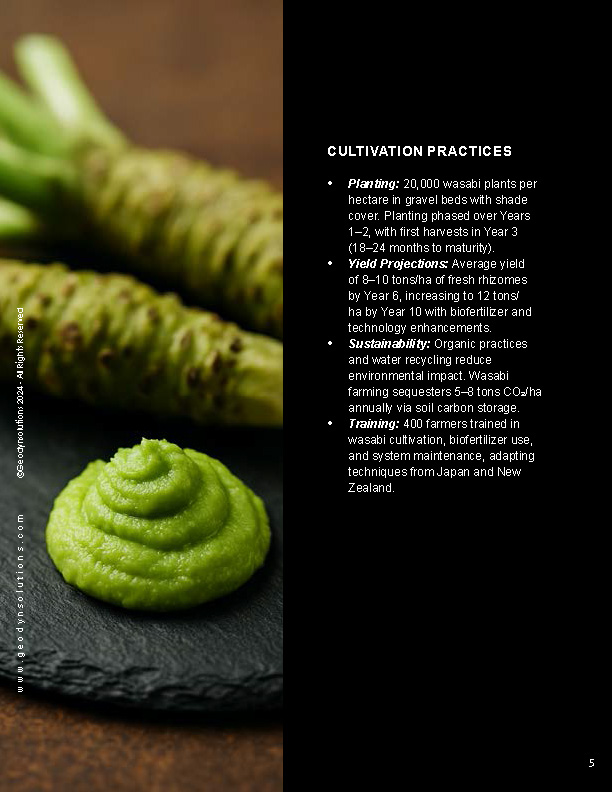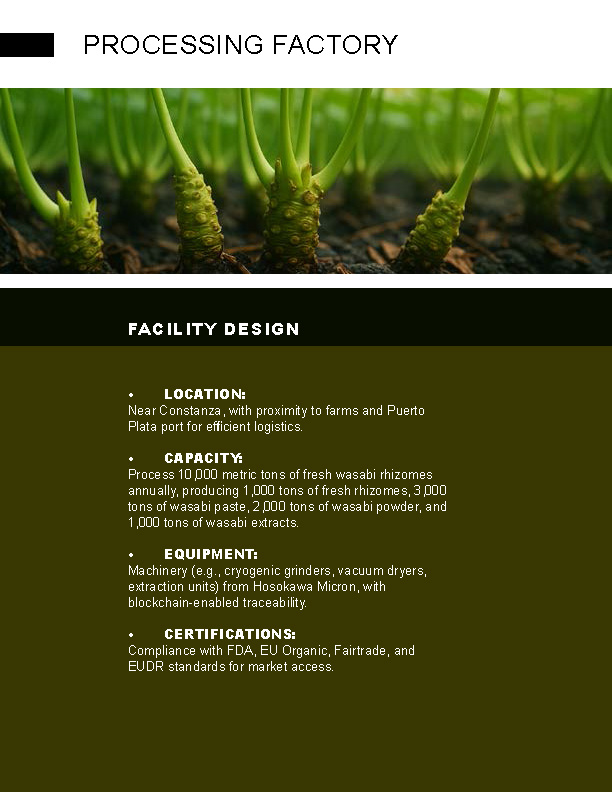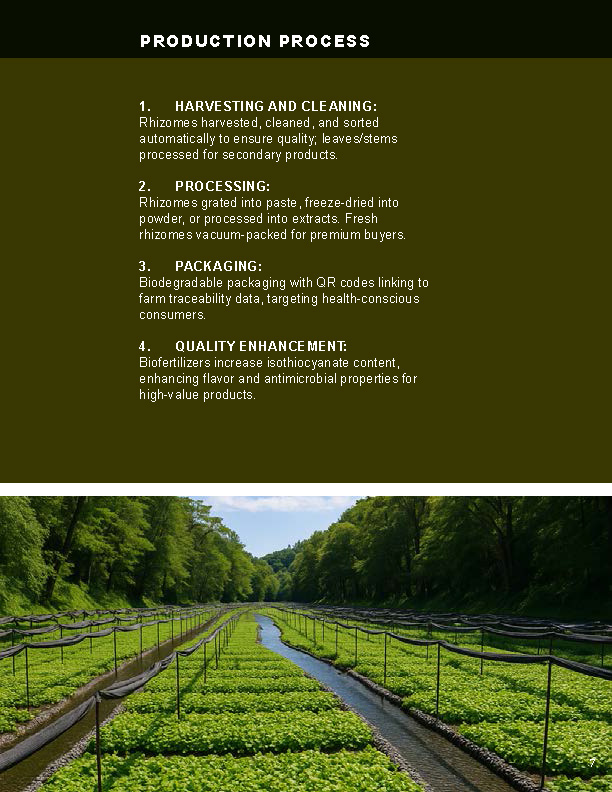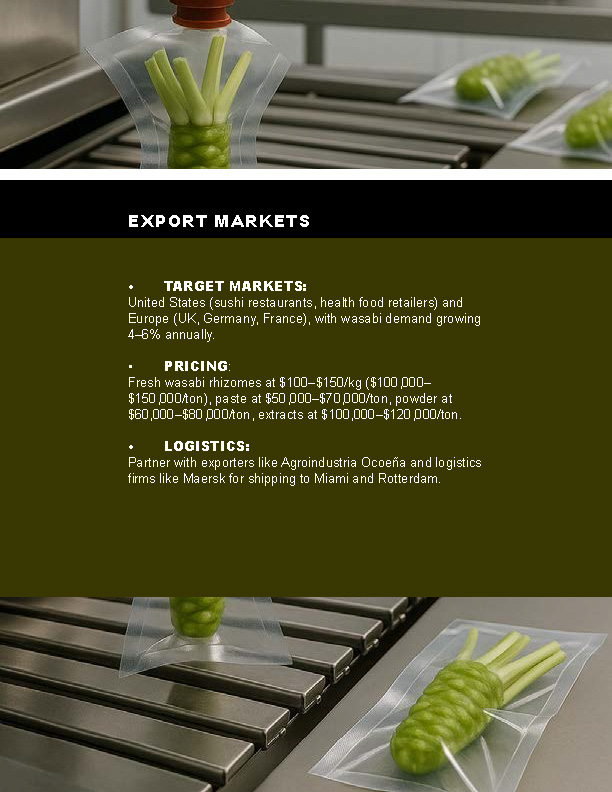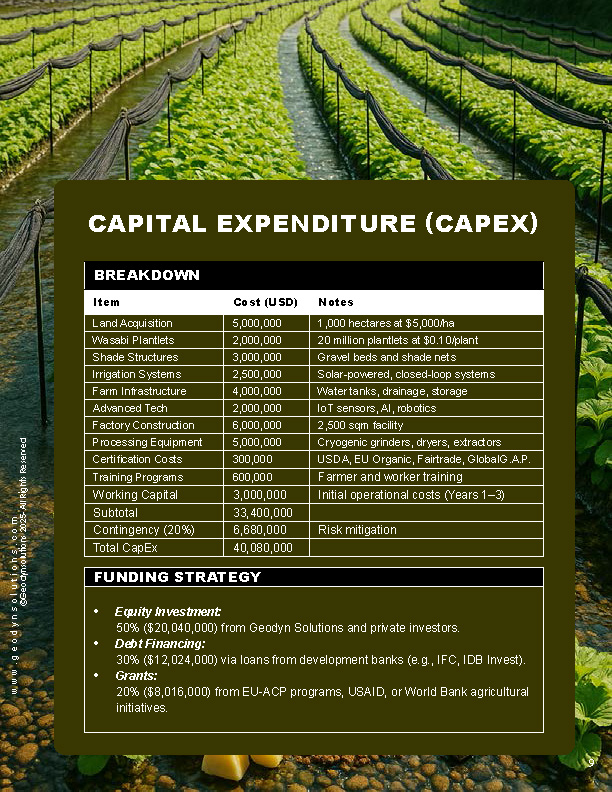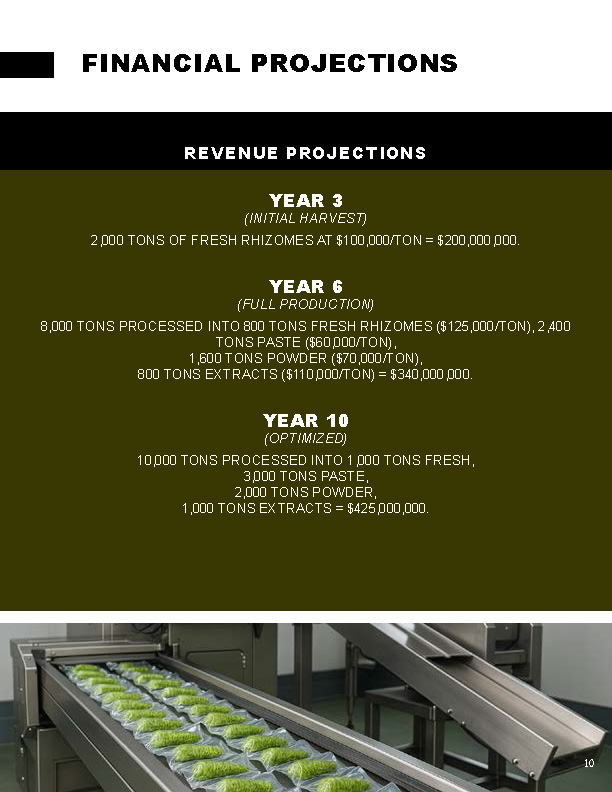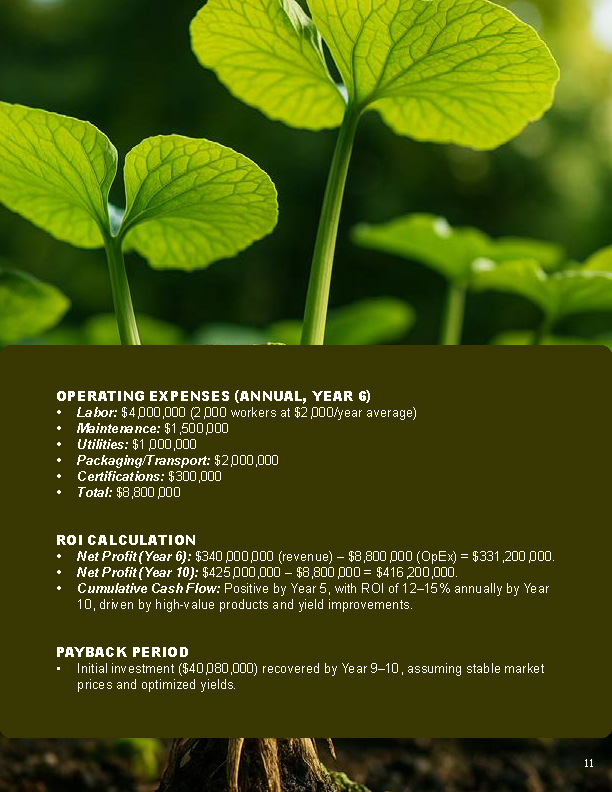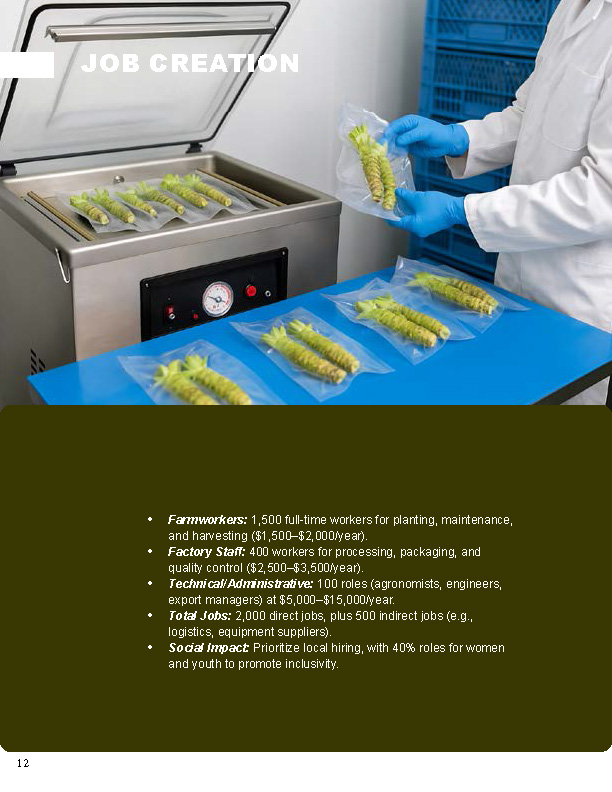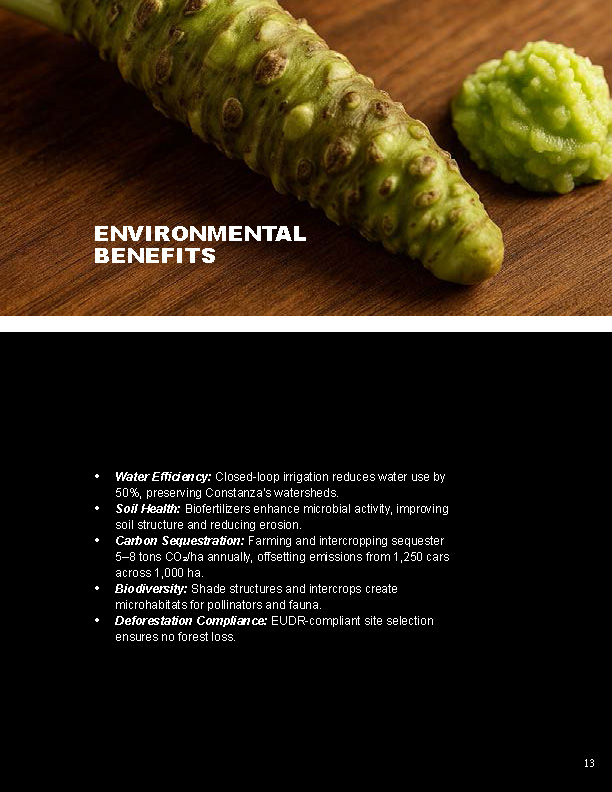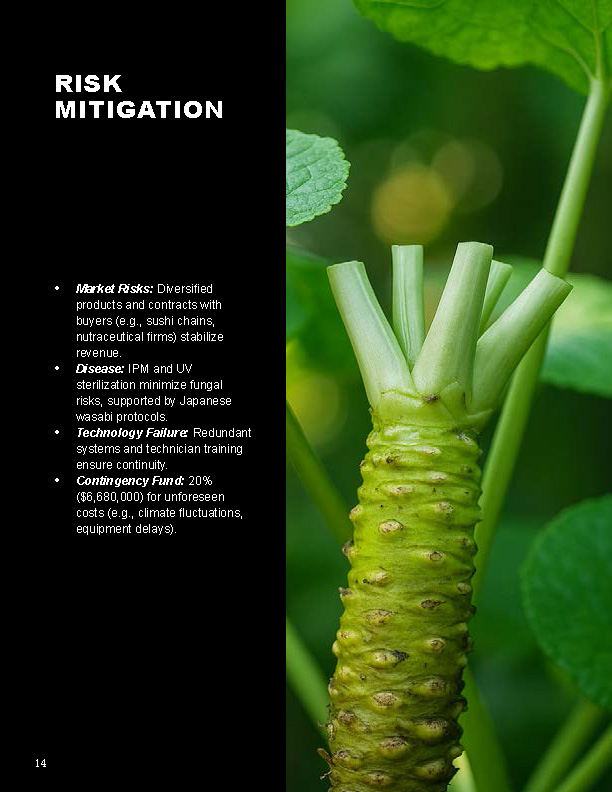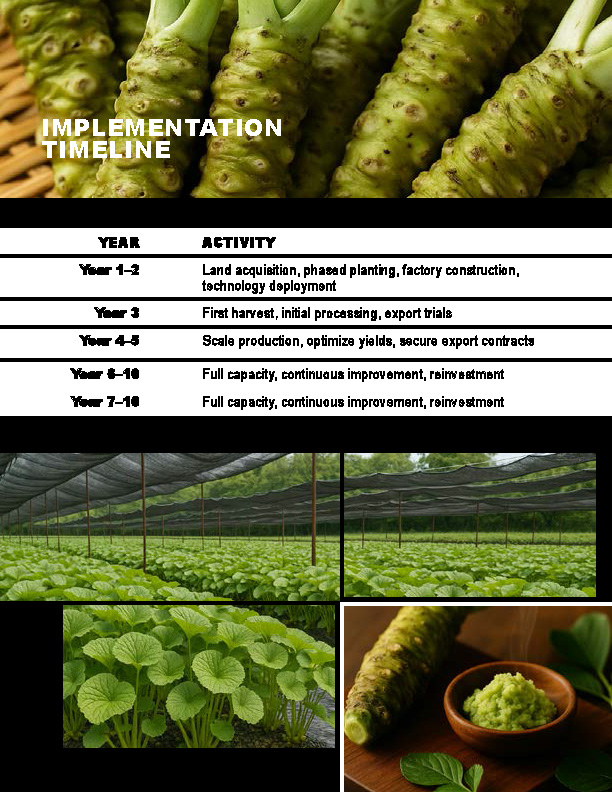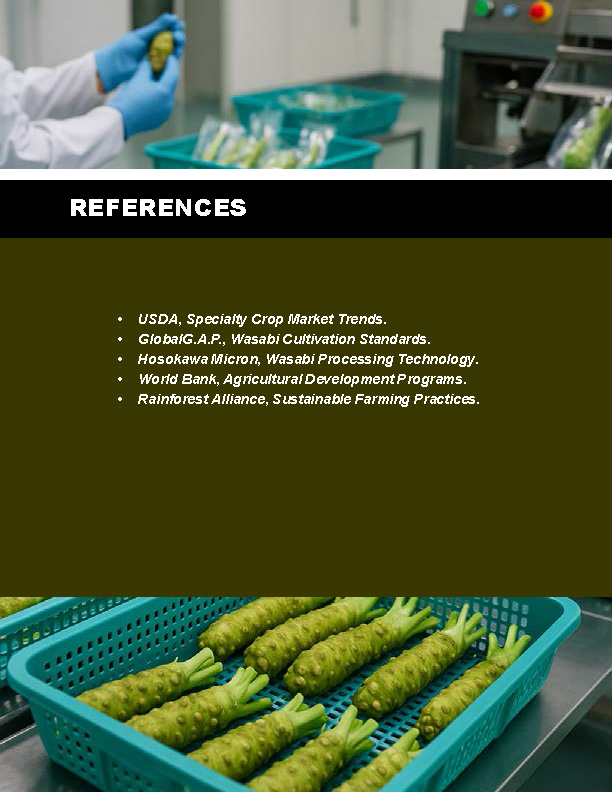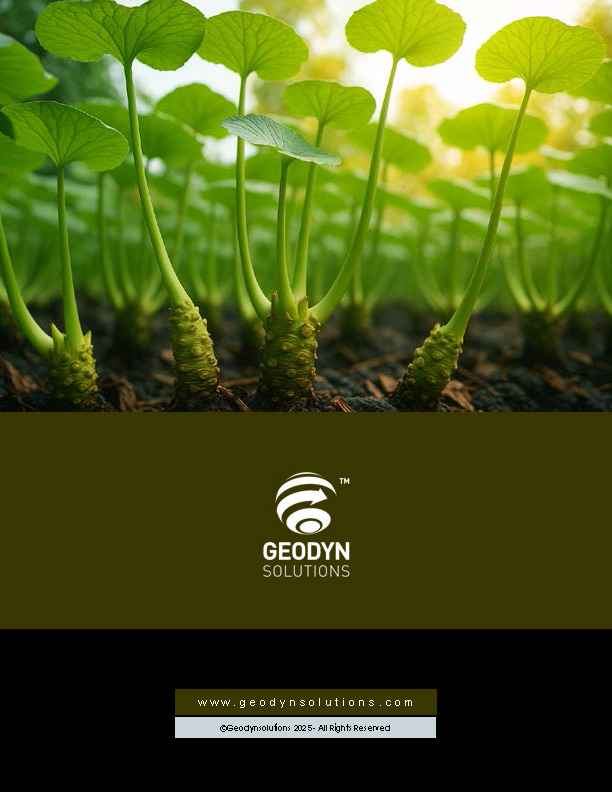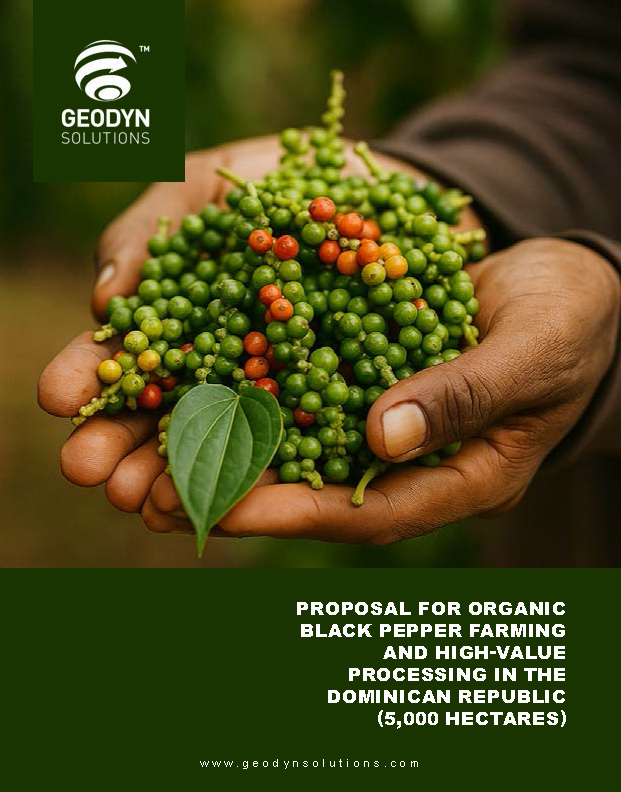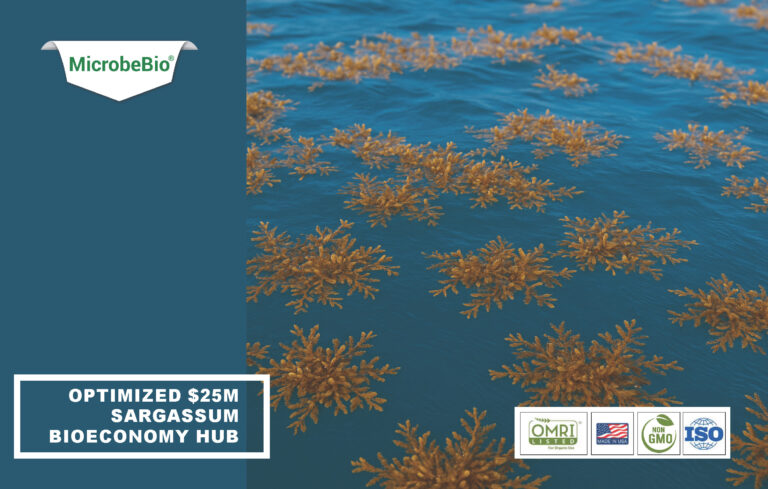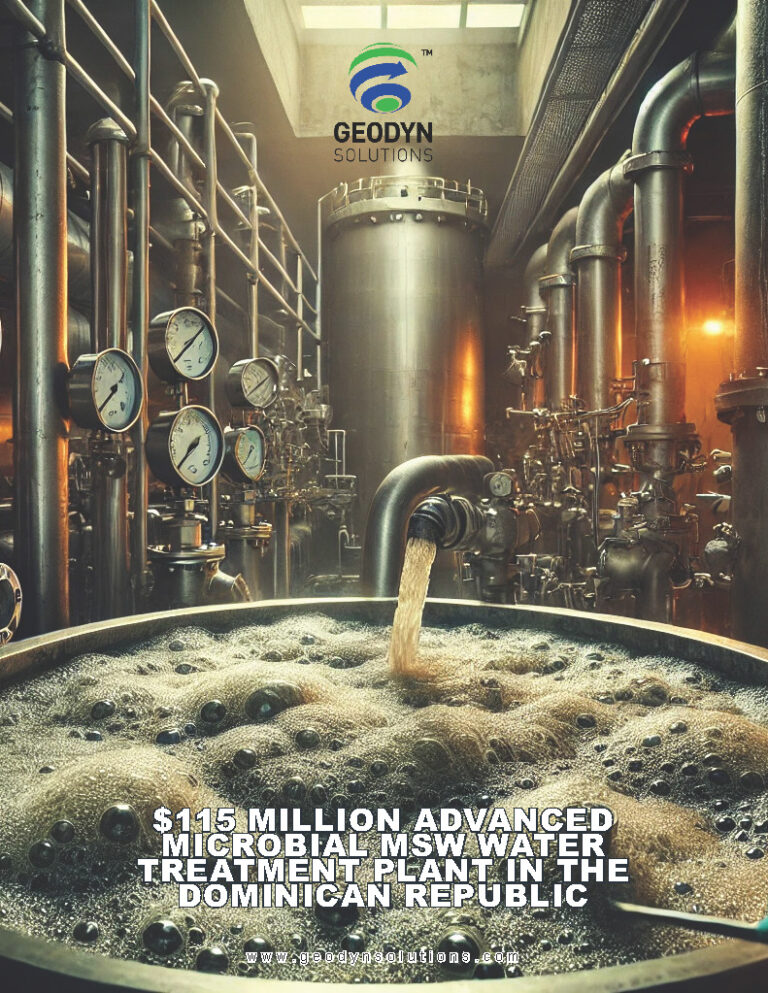Proposal for Organic Wasabi Farming and High-Value Processing in the Dominican Republic (1,000 Hectares)
Executive Summary
Geodyn Solutions proposes developing a 1,000-hectare organic wasabi plantation and a modern processing factory in the Dominican Republic to produce high-value wasabi products (fresh wasabi rhizomes, wasabi paste, powder, and extracts) for export to the United States and Europe. Utilizing advanced agricultural technologies, biofertilizers, and controlled-environment farming, this project will maximize yield, enhance quality, and improve nutrient profiles. The initiative will create 2,000–2,500 jobs, deliver a 12–15% return on investment (ROI), and provide environmental benefits, with a 20% contingency fee to mitigate risks.
Project Overview
Objectives
- Agricultural Development: Cultivate 1,000 hectares of organic wasabi using advanced technologies and biofertilizers to achieve high yields and premium quality.
- Processing Facility: Build a factory to produce fresh wasabi rhizomes, paste, powder, and extracts for export to high-value markets.
- Economic Impact: Generate 2,000–2,500 direct and indirect jobs, including farmworkers, factory staff, and technical roles.
- Environmental Benefits: Minimize water and land use, enhance soil health, and reduce carbon footprint through organic practices and efficient systems.
- Financial Viability: Achieve a projected ROI of 12–15% annually after Year 6, with a payback period of 9–10 years.
Location
The project will be located in the high-altitude region of Constanza (La Vega province), where cool temperatures (15–20°C) and abundant water resources support wasabi growth. Sites will comply with the European Union Deforestation Regulation (EUDR) and avoid protected areas.
Agricultural Plan
Farm Design
- Size: 1,000 hectares, divided into 200 plots of 5 hectares, each with controlled-environment systems (shade structures and hydroponic beds) for optimal wasabi growth.
- Cultivation Model: Wasabi grown in semi-hydroponic gravel beds under shade nets, intercropped with low-growing herbs (e.g., mint, cilantro) to maximize land use and diversify income.
- Wasabi Varieties: Daruma and Mazuma cultivars, sourced from certified suppliers, optimized for flavor and export markets.
- Organic Certification: Adherence to USDA Organic, EU Organic, Fairtrade, and GlobalG.A.P. standards for premium market access.
Advanced Agricultural Technologies
- Biofertilizers: Microbial biofertilizers (e.g., Trichoderma, Bacillus subtilis) to enhance root growth, increase yields by 15–25%, and boost isothiocyanate content for flavor and health benefits.
- Precision Agriculture: IoT sensors for water pH, temperature, and nutrient monitoring, paired with AI-driven growth models to optimize planting and harvesting.
- Irrigation: Closed-loop, solar-powered water circulation systems to maintain constant flow over gravel beds, reducing water use by 50%.
- Pest Management: Integrated pest management (IPM) with biopesticides and UV sterilization to control fungal diseases like Pythium.
- Automation: Robotic harvesting and root sorting systems to improve efficiency and reduce labor costs by 20%.
Cultivation Practices
- Planting: 20,000 wasabi plants per hectare in gravel beds with shade cover. Planting phased over Years 1–2, with first harvests in Year 3 (18–24 months to maturity).
- Yield Projections: Average yield of 8–10 tons/ha of fresh rhizomes by Year 6, increasing to 12 tons/ha by Year 10 with biofertilizer and technology enhancements.
- Sustainability: Organic practices and water recycling reduce environmental impact. Wasabi farming sequesters 5–8 tons CO2/ha annually via soil carbon storage.
- Training: 400 farmers trained in wasabi cultivation, biofertilizer use, and system maintenance, adapting techniques from Japan and New Zealand.
Processing Factory
Facility Design
- Location: Near Constanza, with proximity to farms and Puerto Plata port for efficient logistics.
- Capacity: Process 10,000 metric tons of fresh wasabi rhizomes annually, producing 1,000 tons of fresh rhizomes, 3,000 tons of wasabi paste, 2,000 tons of wasabi powder, and 1,000 tons of wasabi extracts.
- Equipment: Machinery (e.g., cryogenic grinders, vacuum dryers, extraction units) from Hosokawa Micron, with blockchain-enabled traceability.
- Certifications: Compliance with FDA, EU Organic, Fairtrade, and EUDR standards for market access.
Production Process
- Harvesting and Cleaning: Rhizomes harvested, cleaned, and sorted automatically to ensure quality; leaves/stems processed for secondary products.
- Processing: Rhizomes grated into paste, freeze-dried into powder, or processed into extracts. Fresh rhizomes vacuum-packed for premium buyers.
- Packaging: Biodegradable packaging with QR codes linking to farm traceability data, targeting health-conscious consumers.
- Quality Enhancement: Biofertilizers increase isothiocyanate content, enhancing flavor and antimicrobial properties for high-value products.
Export Markets
- Target Markets: United States (sushi restaurants, health food retailers) and Europe (UK, Germany, France), with wasabi demand growing 4–6% annually.
- Pricing: Fresh wasabi rhizomes at $100–$150/kg ($100,000–$150,000/ton), paste at $50,000–$70,000/ton, powder at $60,000–$80,000/ton, extracts at $100,000–$120,000/ton.
- Logistics: Partner with exporters like Agroindustria Ocoeña and logistics firms like Maersk for shipping to Miami and Rotterdam.
Capital Expenditure (CapEx)
Breakdown
Item | Cost (USD) | Notes |
Land Acquisition | 5,000,000 | 1,000 hectares at $5,000/ha |
Wasabi Plantlets | 2,000,000 | 20 million plantlets at $0.10/plant |
Shade Structures | 3,000,000 | Gravel beds and shade nets |
Irrigation Systems | 2,500,000 | Solar-powered, closed-loop systems |
Farm Infrastructure | 4,000,000 | Water tanks, drainage, storage |
Advanced Tech | 2,000,000 | IoT sensors, AI, robotics |
Factory Construction | 6,000,000 | 2,500 sqm facility |
Processing Equipment | 5,000,000 | Cryogenic grinders, dryers, extractors |
Certification Costs | 300,000 | USDA, EU Organic, Fairtrade, GlobalG.A.P. |
Training Programs | 600,000 | Farmer and worker training |
Working Capital | 3,000,000 | Initial operational costs (Years 1–3) |
Subtotal | 33,400,000 | |
Contingency (20%) | 6,680,000 | Risk mitigation |
Total CapEx | 40,080,000 |
Funding Strategy
- Equity Investment: 50% ($20,040,000) from Geodyn Solutions and private investors.
- Debt Financing: 30% ($12,024,000) via loans from development banks (e.g., IFC, IDB Invest).
- Grants: 20% ($8,016,000) from EU-ACP programs, USAID, or World Bank agricultural initiatives.
Financial Projections
Revenue Projections
- Year 3 (Initial Harvest): 2,000 tons of fresh rhizomes at $100,000/ton = $200,000,000.
- Year 6 (Full Production): 8,000 tons processed into 800 tons fresh rhizomes ($125,000/ton), 2,400 tons paste ($60,000/ton), 1,600 tons powder ($70,000/ton), 800 tons extracts ($110,000/ton) = $340,000,000.
- Year 10 (Optimized): 10,000 tons processed into 1,000 tons fresh, 3,000 tons paste, 2,000 tons powder, 1,000 tons extracts = $425,000,000.
Operating Expenses (Annual, Year 6)
- Labor: $4,000,000 (2,000 workers at $2,000/year average)
- Maintenance: $1,500,000
- Utilities: $1,000,000
- Packaging/Transport: $2,000,000
- Certifications: $300,000
- Total: $8,800,000
ROI Calculation
- Net Profit (Year 6): $340,000,000 (revenue) – $8,800,000 (OpEx) = $331,200,000.
- Net Profit (Year 10): $425,000,000 – $8,800,000 = $416,200,000.
- Cumulative Cash Flow: Positive by Year 5, with ROI of 12–15% annually by Year 10, driven by high-value products and yield improvements.
Payback Period
- Initial investment ($40,080,000) recovered by Year 9–10, assuming stable market prices and optimized yields.
Job Creation
- Farmworkers: 1,500 full-time workers for planting, maintenance, and harvesting ($1,500–$2,000/year).
- Factory Staff: 400 workers for processing, packaging, and quality control ($2,500–$3,500/year).
- Technical/Administrative: 100 roles (agronomists, engineers, export managers) at $5,000–$15,000/year.
- Total Jobs: 2,000 direct jobs, plus 500 indirect jobs (e.g., logistics, equipment suppliers).
- Social Impact: Prioritize local hiring, with 40% roles for women and youth to promote inclusivity.
Environmental Benefits
- Water Efficiency: Closed-loop irrigation reduces water use by 50%, preserving Constanza’s watersheds.
- Soil Health: Biofertilizers enhance microbial activity, improving soil structure and reducing erosion.
- Carbon Sequestration: Farming and intercropping sequester 5–8 tons CO2/ha annually, offsetting emissions from 1,250 cars across 1,000 ha.
- Biodiversity: Shade structures and intercrops create microhabitats for pollinators and fauna.
- Deforestation Compliance: EUDR-compliant site selection ensures no forest loss.
Risk Mitigation
- Market Risks: Diversified products and contracts with buyers (e.g., sushi chains, nutraceutical firms) stabilize revenue.
- Disease: IPM and UV sterilization minimize fungal risks, supported by Japanese wasabi protocols.
- Technology Failure: Redundant systems and technician training ensure continuity.
- Contingency Fund: 20% ($6,680,000) for unforeseen costs (e.g., climate fluctuations, equipment delays).
Implementation Timeline
Year | Activity |
Year 1–2 | Land acquisition, phased planting, factory construction, technology deployment |
Year 3 | First harvest, initial processing, export trials |
Year 4–5 | Scale production, optimize yields, secure export contracts |
Year 6–10 | Full capacity, continuous improvement, reinvestment |
Conclusion
Geodyn Solutions’ 1,000-hectare organic wasabi plantation and high-value processing factory will establish the Dominican Republic as a key player in premium wasabi products. With a $40.08 million investment, the project will create 2,000–2,500 jobs, achieve a 12–15% ROI by Year 10, and deliver environmental benefits through advanced technologies and biofertilizers. The 20% contingency fee ensures resilience, making this a viable venture for economic and ecological sustainability.
References
- USDA, Specialty Crop Market Trends.
- A.P., Wasabi Cultivation Standards.
- Hosokawa Micron, Wasabi Processing Technology.
- World Bank, Agricultural Development Programs.
- Rainforest Alliance, Sustainable Farming Practices.
